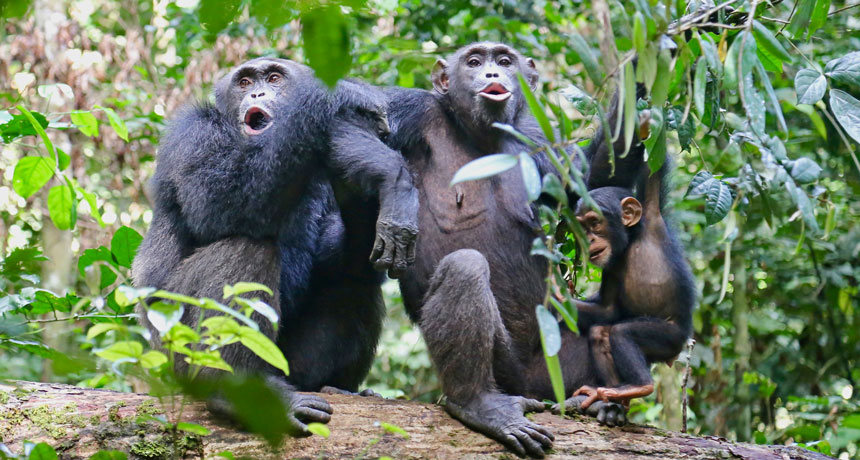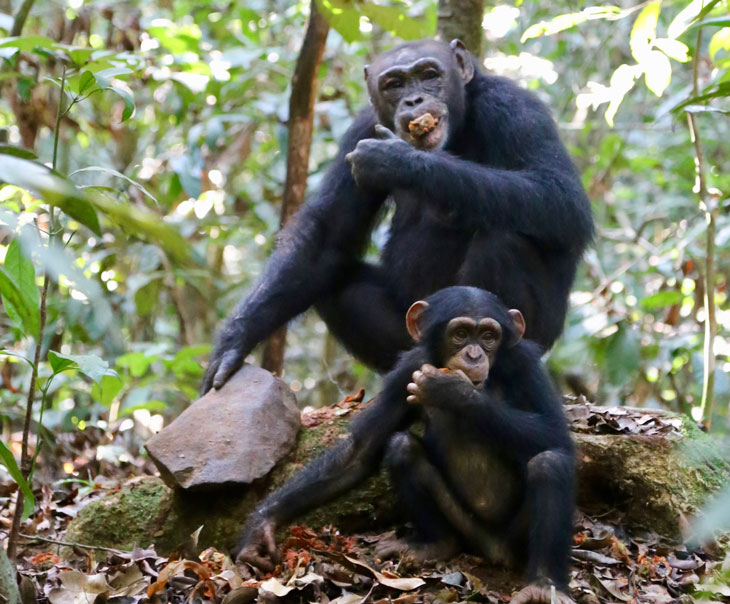Human encroachment threatens chimpanzee culture
Environmental disruptions reduce opportunities for social learning

MAKING NOISE Primatologists are concerned that deforestation and other disturbances are affecting the behavioral repertoire of chimpanzees in Taï National Park in Côte d’Ivoire (shown) and elsewhere.
© Liran Samuni/Taï Chimpanzee Project
From deep inside chimpanzee territory, the fieldworkers heard loud bangs and shouts. Hidden video cameras later revealed what the chimps in the Boé region of Guinea-Bissau were up to. Males were throwing rocks at trees and yelling.
Researchers don’t fully understand why the apes engage in this rare behavior, known as accumulative stone throwing. And scientists may not have much time to sort out what’s going on.
All four of Africa’s subspecies of chimpanzees are under threat from deforestation and poaching. That and other human activity may also be affecting chimp behaviors, including ones that many primatologists view as evidence of chimp culture — behaviors that are learned socially and transmitted through generations, Ammie Kalan and colleagues report online March 7 in Science. Such traditions as cave dwelling, using sticks to dig for honey and cracking nuts with stones are far less likely to occur in areas most impacted by humans, compared with more remote chimp territories, the team found.
“Everyone thinks that if populations are declining … there would be some loss in the transmission chain that leads to cultural diversity in animals,” says Kalan, of the Max Planck Institute for Evolutionary Anthropology in Leipzig, Germany. “We’re the first to really show this.”
The group set out to test the disturbance hypothesis put forth by Carel van Schaik, now of the University of Zurich, in 2002. That hypothesis suggests that disturbances, including population loss, resource depletion and habitat fragmentation, break down the opportunities needed for social learning to occur. By extension, cultural traditions will die out before the species itself. But van Schaik, an orangutan expert, lacked the data to prove his hypothesis.
Starting in 2010, Max Planck researchers began installing automated video cameras at 46 chimpanzee sites and, with the help of citizen scientists, sifted through millions of one-minute clips to identify thousands of chimp videos. The team also surveyed those chimp sites for feeding remains, signs of tool use and fecal samples to see what the animals were eating.
The researchers next combed through about 450 studies from 1951 to 2017 that documented chimpanzee behavior or culture. The final analysis included 144 chimpanzee communities and 31 potentially cultural behaviors, such using moss as a sponge, using sticks to fish for algae and, of course, hurtling rocks at trees.
The team then sought to quantify the human impact on each chimp community with data from a collaborative project that uses satellite images to estimate the impact of infrastructure, human population density, forest cover and remoteness. With a resolution of 1 square kilometer and chimp communities typically spanning 25 to 100 square kilometers, those images provide a detailed snapshot of the chimps’ living situations.
That analysis revealed that the 31 chimpanzee behaviors were 88 percent less likely to occur in the areas more affected by human activities compared with the lowest. Though the findings don’t directly prove that human activity caused a decrease in chimp behavioral diversity, the results support the disturbance hypothesis, says van Schaik, who was not involved in this study.
His own recent work suggests that such behaviors in orangutans appear vital to survival, with the loss of key individuals leading to rapid losses in skills. “Culture is not the tip of the iceberg for these great apes — some kind of nice luxury — but an intrinsic and essential part of their local adaptation,” he explained in an e-mail.

Now, Kalan, who joined the Max Planck project in 2015, and her colleagues are urging conservationists to create preserves around chimpanzee communities that show unique behaviors. Such chimpanzee cultural heritage sites could protect the chimpanzees’ behavioral diversity, she says.
“Animal culture matters for conservation,” agrees Andrew Whiten, a primatologist at the University of St. Andrews in Fife, Scotland. He’s a coauthor of a study in the March 8 Science that looks at modes of cultural transmission across the animal kingdom — including among chimpanzees, whales, migratory birds and elephants — and the often dire consequences of breaking those knowledge chains.
To date, Kalan’s team has discovered only four chimpanzee communities in West Africa where stone throwing occurs. For now, she can only speculate about the chimps’ motivations. Maybe they’re trying to communicate with other group members through the loud “bang” of the stone against the tree or creating the chimpanzee equivalent of cairns on a hiking trail. Protecting the homes of these and other chimp groups could preserve such behaviors long enough for researchers to find the answers — and for the chimps to go on doing what they do.






